Environmental Policy Project for Koala City: A Comprehensive Tender
VerifiedAdded on 2023/06/07
|30
|7105
|194
Report
AI Summary
This project report outlines an environmental policy tender for Koala City, focusing on mitigating pollution and promoting sustainability through initiatives like solar power grids, water filtration, and waste management programs. The report details project requirements, scope, schedule, and costs, including a work breakdown structure, Gantt chart, and project milestones. Stakeholder analysis and communication strategies are discussed, along with project risks and success measures. The procurement process, including outsourcing decisions and supplier selection, is also covered. The report emphasizes the importance of legislative and technical requirements to achieve a healthier environment for Koala City, advocating for renewable energy sources, electric vehicles, and efficient resource management, aiming for sustainable development and intergenerational coordination. Desklib offers a platform to explore similar solved assignments and project reports.
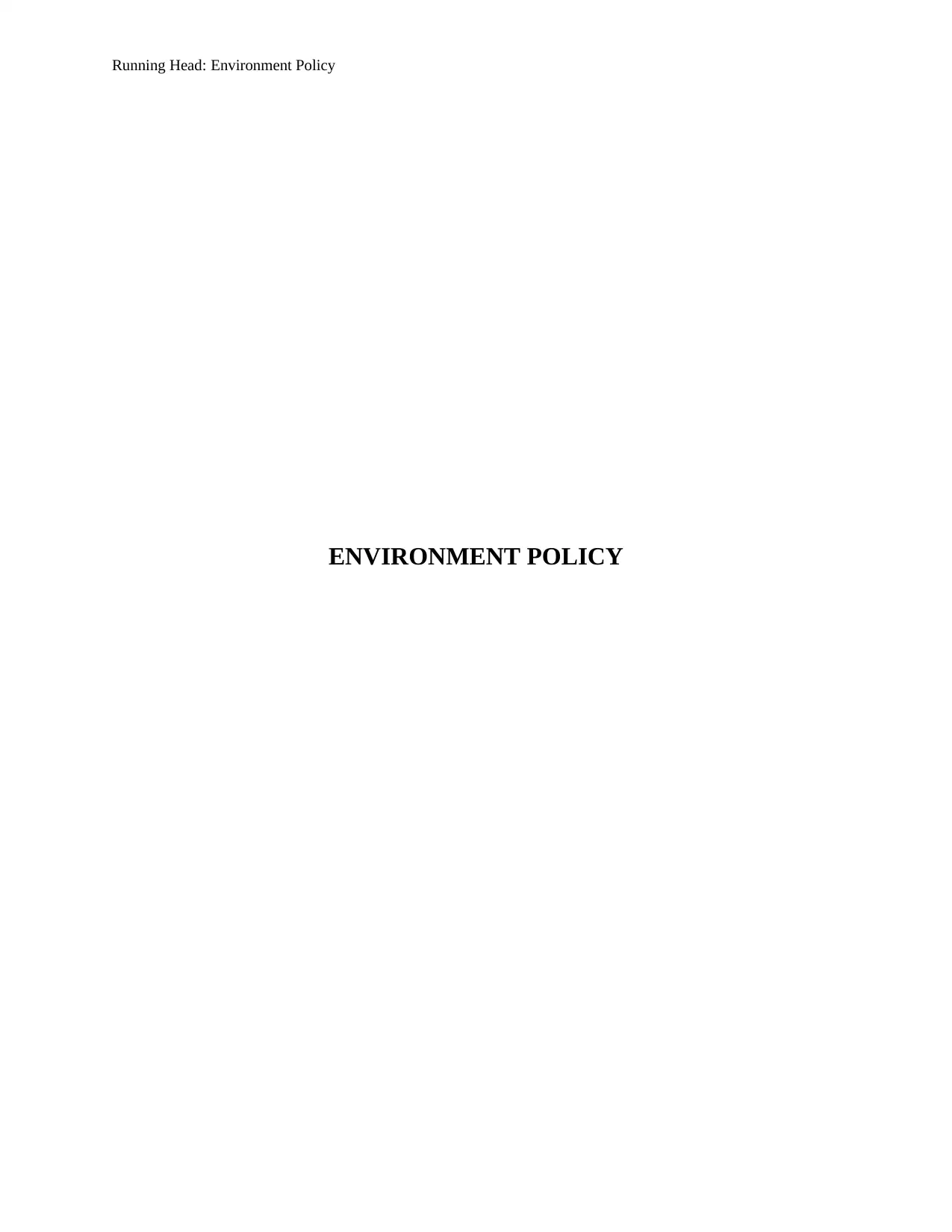
Running Head: Environment Policy
ENVIRONMENT POLICY
ENVIRONMENT POLICY
Paraphrase This Document
Need a fresh take? Get an instant paraphrase of this document with our AI Paraphraser
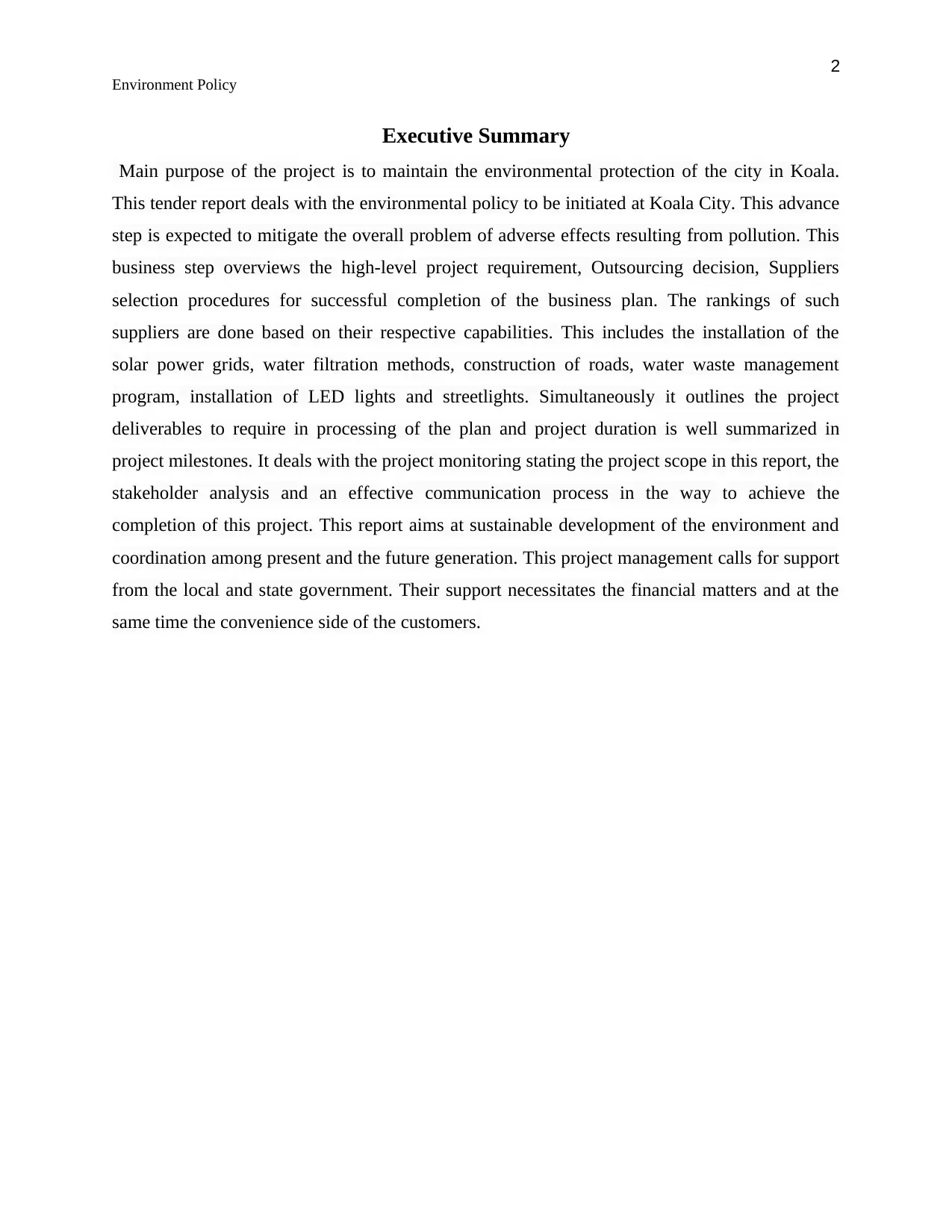
2
Environment Policy
Executive Summary
Main purpose of the project is to maintain the environmental protection of the city in Koala.
This tender report deals with the environmental policy to be initiated at Koala City. This advance
step is expected to mitigate the overall problem of adverse effects resulting from pollution. This
business step overviews the high-level project requirement, Outsourcing decision, Suppliers
selection procedures for successful completion of the business plan. The rankings of such
suppliers are done based on their respective capabilities. This includes the installation of the
solar power grids, water filtration methods, construction of roads, water waste management
program, installation of LED lights and streetlights. Simultaneously it outlines the project
deliverables to require in processing of the plan and project duration is well summarized in
project milestones. It deals with the project monitoring stating the project scope in this report, the
stakeholder analysis and an effective communication process in the way to achieve the
completion of this project. This report aims at sustainable development of the environment and
coordination among present and the future generation. This project management calls for support
from the local and state government. Their support necessitates the financial matters and at the
same time the convenience side of the customers.
Environment Policy
Executive Summary
Main purpose of the project is to maintain the environmental protection of the city in Koala.
This tender report deals with the environmental policy to be initiated at Koala City. This advance
step is expected to mitigate the overall problem of adverse effects resulting from pollution. This
business step overviews the high-level project requirement, Outsourcing decision, Suppliers
selection procedures for successful completion of the business plan. The rankings of such
suppliers are done based on their respective capabilities. This includes the installation of the
solar power grids, water filtration methods, construction of roads, water waste management
program, installation of LED lights and streetlights. Simultaneously it outlines the project
deliverables to require in processing of the plan and project duration is well summarized in
project milestones. It deals with the project monitoring stating the project scope in this report, the
stakeholder analysis and an effective communication process in the way to achieve the
completion of this project. This report aims at sustainable development of the environment and
coordination among present and the future generation. This project management calls for support
from the local and state government. Their support necessitates the financial matters and at the
same time the convenience side of the customers.
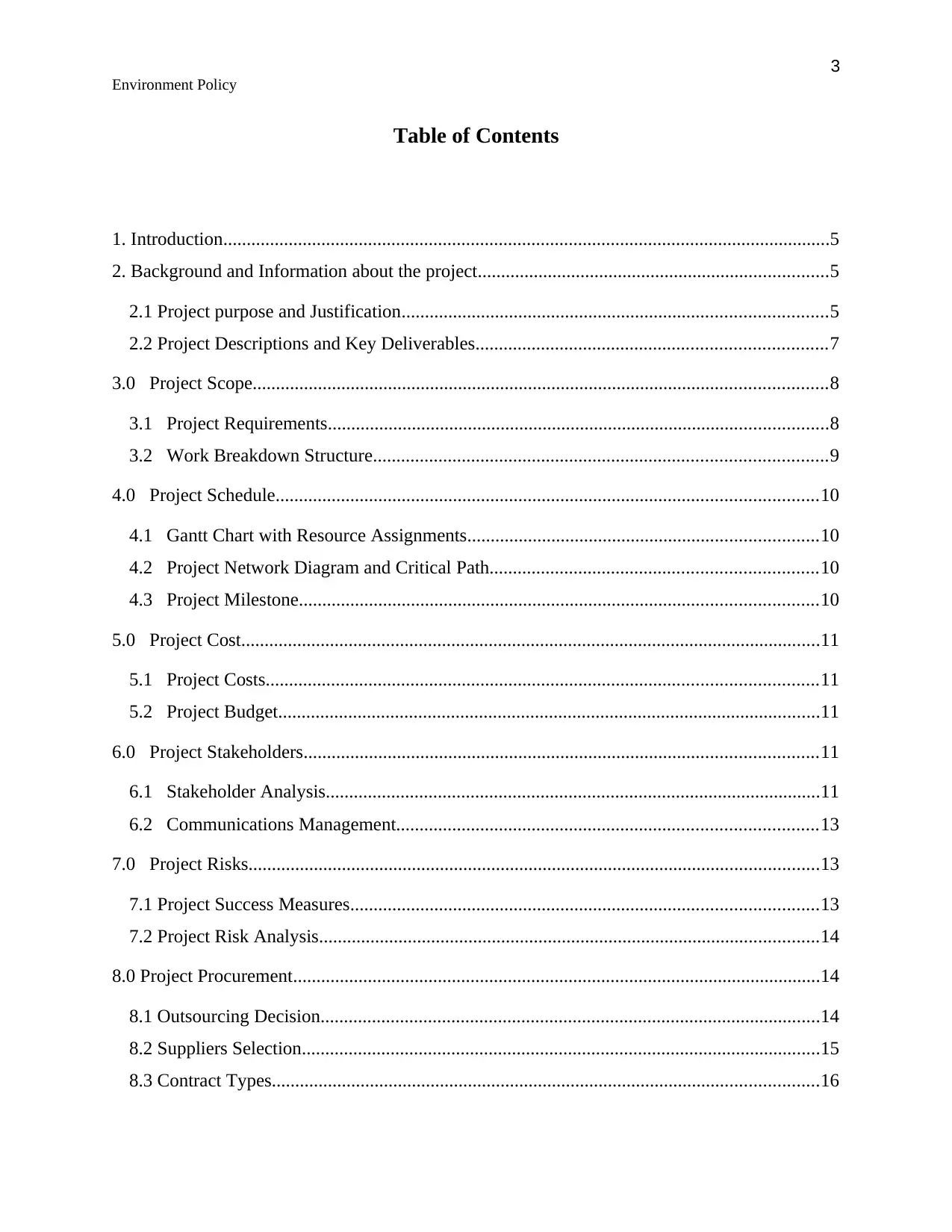
3
Environment Policy
Table of Contents
1. Introduction..................................................................................................................................5
2. Background and Information about the project...........................................................................5
2.1 Project purpose and Justification...........................................................................................5
2.2 Project Descriptions and Key Deliverables...........................................................................7
3.0 Project Scope...........................................................................................................................8
3.1 Project Requirements...........................................................................................................8
3.2 Work Breakdown Structure.................................................................................................9
4.0 Project Schedule....................................................................................................................10
4.1 Gantt Chart with Resource Assignments...........................................................................10
4.2 Project Network Diagram and Critical Path......................................................................10
4.3 Project Milestone...............................................................................................................10
5.0 Project Cost............................................................................................................................11
5.1 Project Costs......................................................................................................................11
5.2 Project Budget....................................................................................................................11
6.0 Project Stakeholders..............................................................................................................11
6.1 Stakeholder Analysis..........................................................................................................11
6.2 Communications Management..........................................................................................13
7.0 Project Risks..........................................................................................................................13
7.1 Project Success Measures....................................................................................................13
7.2 Project Risk Analysis...........................................................................................................14
8.0 Project Procurement.................................................................................................................14
8.1 Outsourcing Decision...........................................................................................................14
8.2 Suppliers Selection...............................................................................................................15
8.3 Contract Types.....................................................................................................................16
Environment Policy
Table of Contents
1. Introduction..................................................................................................................................5
2. Background and Information about the project...........................................................................5
2.1 Project purpose and Justification...........................................................................................5
2.2 Project Descriptions and Key Deliverables...........................................................................7
3.0 Project Scope...........................................................................................................................8
3.1 Project Requirements...........................................................................................................8
3.2 Work Breakdown Structure.................................................................................................9
4.0 Project Schedule....................................................................................................................10
4.1 Gantt Chart with Resource Assignments...........................................................................10
4.2 Project Network Diagram and Critical Path......................................................................10
4.3 Project Milestone...............................................................................................................10
5.0 Project Cost............................................................................................................................11
5.1 Project Costs......................................................................................................................11
5.2 Project Budget....................................................................................................................11
6.0 Project Stakeholders..............................................................................................................11
6.1 Stakeholder Analysis..........................................................................................................11
6.2 Communications Management..........................................................................................13
7.0 Project Risks..........................................................................................................................13
7.1 Project Success Measures....................................................................................................13
7.2 Project Risk Analysis...........................................................................................................14
8.0 Project Procurement.................................................................................................................14
8.1 Outsourcing Decision...........................................................................................................14
8.2 Suppliers Selection...............................................................................................................15
8.3 Contract Types.....................................................................................................................16
⊘ This is a preview!⊘
Do you want full access?
Subscribe today to unlock all pages.

Trusted by 1+ million students worldwide
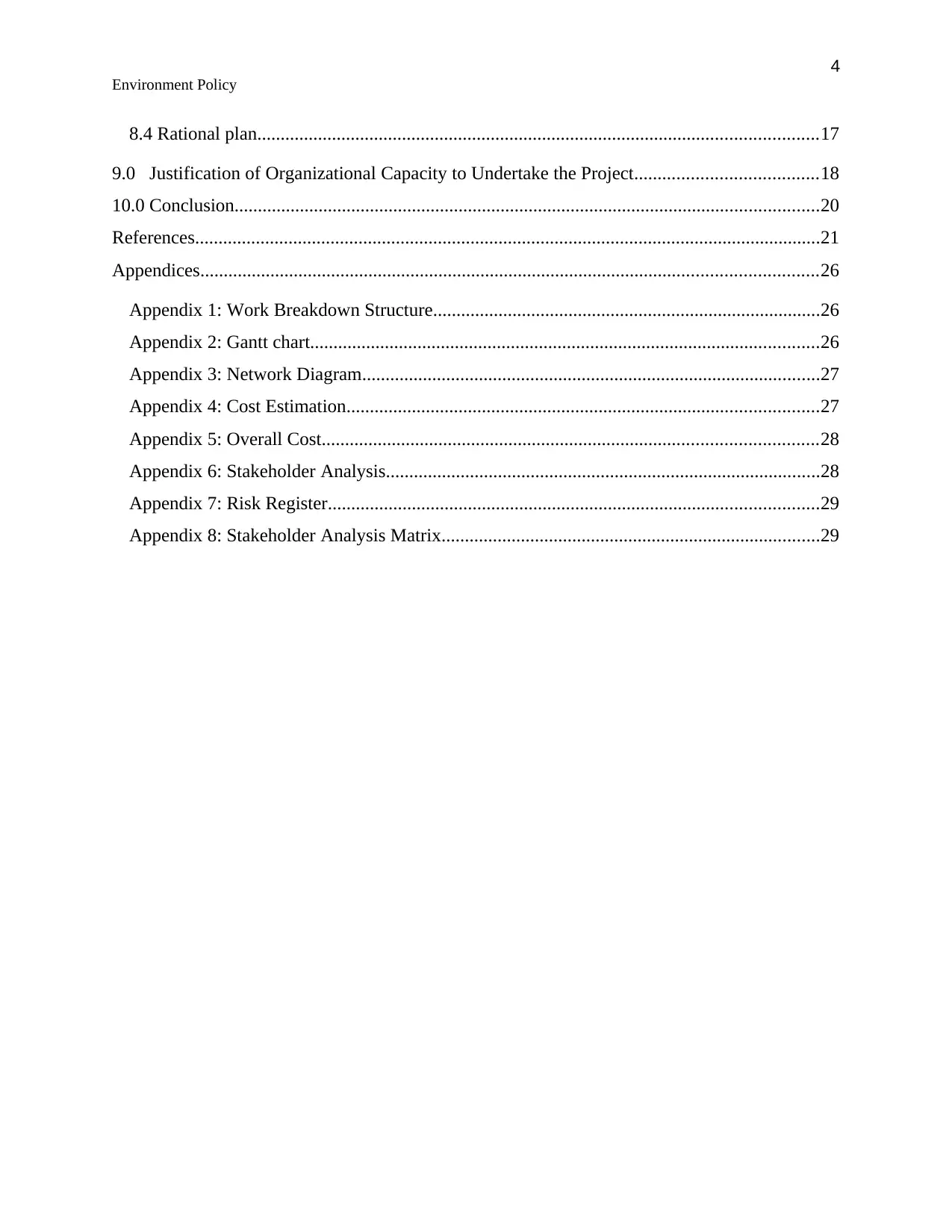
4
Environment Policy
8.4 Rational plan........................................................................................................................17
9.0 Justification of Organizational Capacity to Undertake the Project.......................................18
10.0 Conclusion.............................................................................................................................20
References......................................................................................................................................21
Appendices....................................................................................................................................26
Appendix 1: Work Breakdown Structure...................................................................................26
Appendix 2: Gantt chart.............................................................................................................26
Appendix 3: Network Diagram..................................................................................................27
Appendix 4: Cost Estimation.....................................................................................................27
Appendix 5: Overall Cost..........................................................................................................28
Appendix 6: Stakeholder Analysis.............................................................................................28
Appendix 7: Risk Register.........................................................................................................29
Appendix 8: Stakeholder Analysis Matrix.................................................................................29
Environment Policy
8.4 Rational plan........................................................................................................................17
9.0 Justification of Organizational Capacity to Undertake the Project.......................................18
10.0 Conclusion.............................................................................................................................20
References......................................................................................................................................21
Appendices....................................................................................................................................26
Appendix 1: Work Breakdown Structure...................................................................................26
Appendix 2: Gantt chart.............................................................................................................26
Appendix 3: Network Diagram..................................................................................................27
Appendix 4: Cost Estimation.....................................................................................................27
Appendix 5: Overall Cost..........................................................................................................28
Appendix 6: Stakeholder Analysis.............................................................................................28
Appendix 7: Risk Register.........................................................................................................29
Appendix 8: Stakeholder Analysis Matrix.................................................................................29
Paraphrase This Document
Need a fresh take? Get an instant paraphrase of this document with our AI Paraphraser
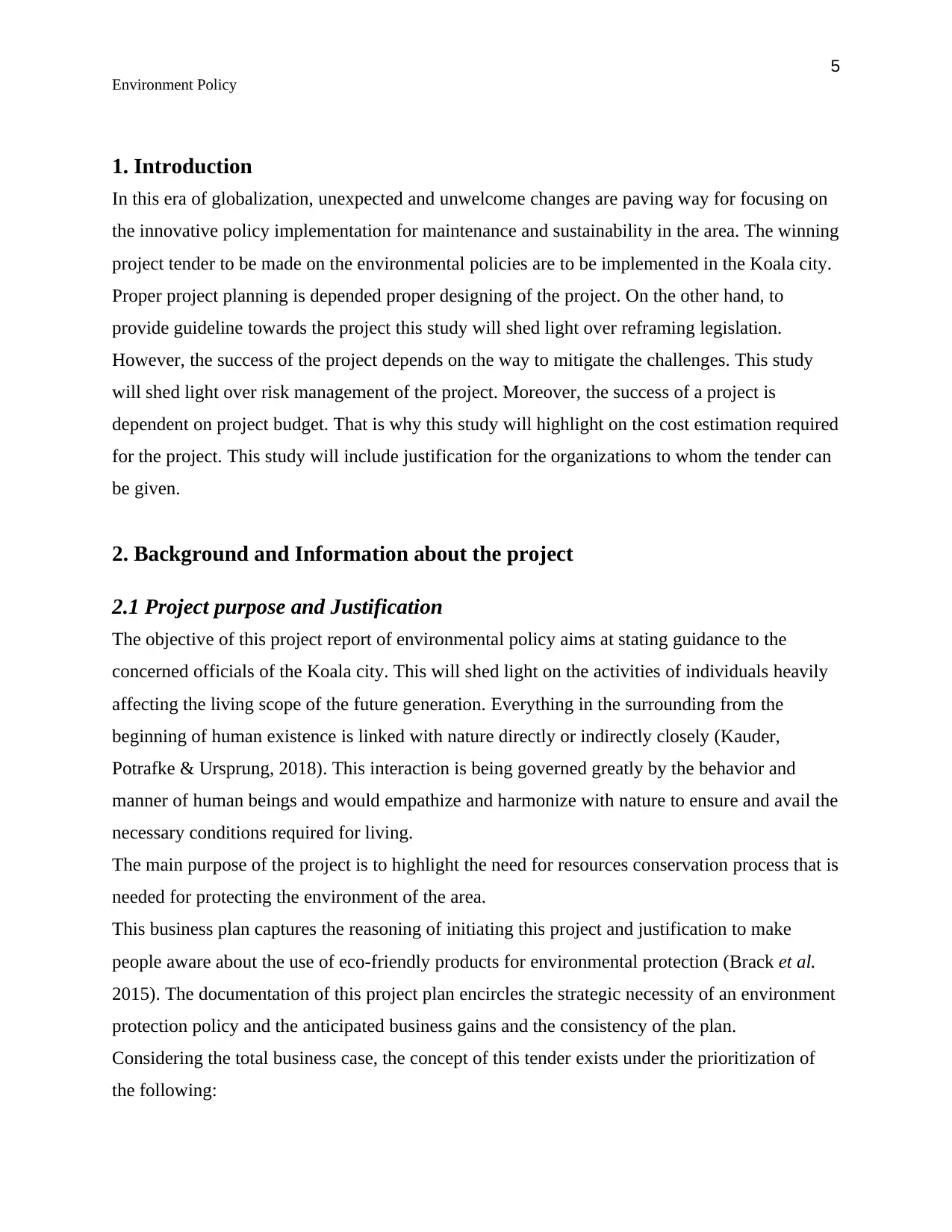
5
Environment Policy
1. Introduction
In this era of globalization, unexpected and unwelcome changes are paving way for focusing on
the innovative policy implementation for maintenance and sustainability in the area. The winning
project tender to be made on the environmental policies are to be implemented in the Koala city.
Proper project planning is depended proper designing of the project. On the other hand, to
provide guideline towards the project this study will shed light over reframing legislation.
However, the success of the project depends on the way to mitigate the challenges. This study
will shed light over risk management of the project. Moreover, the success of a project is
dependent on project budget. That is why this study will highlight on the cost estimation required
for the project. This study will include justification for the organizations to whom the tender can
be given.
2. Background and Information about the project
2.1 Project purpose and Justification
The objective of this project report of environmental policy aims at stating guidance to the
concerned officials of the Koala city. This will shed light on the activities of individuals heavily
affecting the living scope of the future generation. Everything in the surrounding from the
beginning of human existence is linked with nature directly or indirectly closely (Kauder,
Potrafke & Ursprung, 2018). This interaction is being governed greatly by the behavior and
manner of human beings and would empathize and harmonize with nature to ensure and avail the
necessary conditions required for living.
The main purpose of the project is to highlight the need for resources conservation process that is
needed for protecting the environment of the area.
This business plan captures the reasoning of initiating this project and justification to make
people aware about the use of eco-friendly products for environmental protection (Brack et al.
2015). The documentation of this project plan encircles the strategic necessity of an environment
protection policy and the anticipated business gains and the consistency of the plan.
Considering the total business case, the concept of this tender exists under the prioritization of
the following:
Environment Policy
1. Introduction
In this era of globalization, unexpected and unwelcome changes are paving way for focusing on
the innovative policy implementation for maintenance and sustainability in the area. The winning
project tender to be made on the environmental policies are to be implemented in the Koala city.
Proper project planning is depended proper designing of the project. On the other hand, to
provide guideline towards the project this study will shed light over reframing legislation.
However, the success of the project depends on the way to mitigate the challenges. This study
will shed light over risk management of the project. Moreover, the success of a project is
dependent on project budget. That is why this study will highlight on the cost estimation required
for the project. This study will include justification for the organizations to whom the tender can
be given.
2. Background and Information about the project
2.1 Project purpose and Justification
The objective of this project report of environmental policy aims at stating guidance to the
concerned officials of the Koala city. This will shed light on the activities of individuals heavily
affecting the living scope of the future generation. Everything in the surrounding from the
beginning of human existence is linked with nature directly or indirectly closely (Kauder,
Potrafke & Ursprung, 2018). This interaction is being governed greatly by the behavior and
manner of human beings and would empathize and harmonize with nature to ensure and avail the
necessary conditions required for living.
The main purpose of the project is to highlight the need for resources conservation process that is
needed for protecting the environment of the area.
This business plan captures the reasoning of initiating this project and justification to make
people aware about the use of eco-friendly products for environmental protection (Brack et al.
2015). The documentation of this project plan encircles the strategic necessity of an environment
protection policy and the anticipated business gains and the consistency of the plan.
Considering the total business case, the concept of this tender exists under the prioritization of
the following:
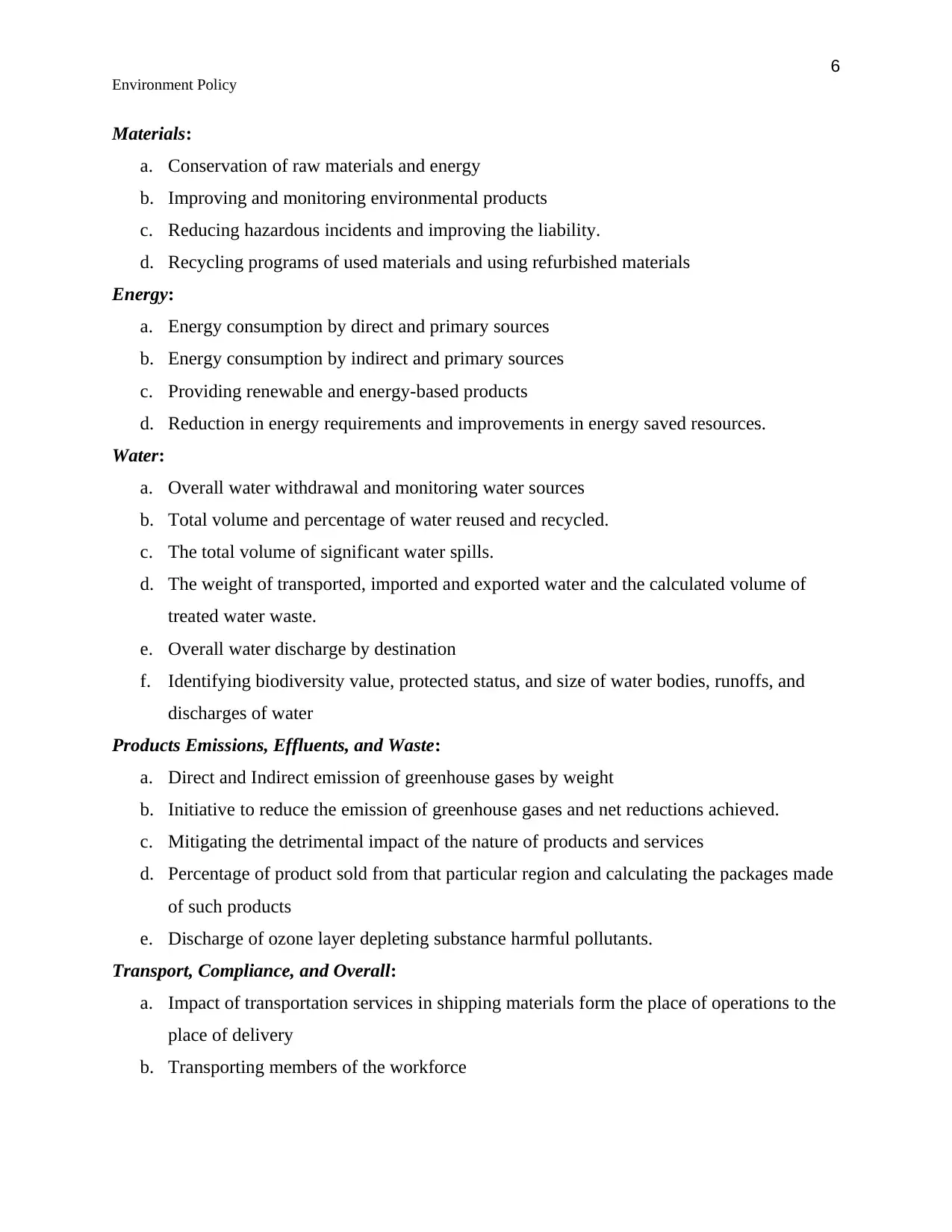
6
Environment Policy
Materials:
a. Conservation of raw materials and energy
b. Improving and monitoring environmental products
c. Reducing hazardous incidents and improving the liability.
d. Recycling programs of used materials and using refurbished materials
Energy:
a. Energy consumption by direct and primary sources
b. Energy consumption by indirect and primary sources
c. Providing renewable and energy-based products
d. Reduction in energy requirements and improvements in energy saved resources.
Water:
a. Overall water withdrawal and monitoring water sources
b. Total volume and percentage of water reused and recycled.
c. The total volume of significant water spills.
d. The weight of transported, imported and exported water and the calculated volume of
treated water waste.
e. Overall water discharge by destination
f. Identifying biodiversity value, protected status, and size of water bodies, runoffs, and
discharges of water
Products Emissions, Effluents, and Waste:
a. Direct and Indirect emission of greenhouse gases by weight
b. Initiative to reduce the emission of greenhouse gases and net reductions achieved.
c. Mitigating the detrimental impact of the nature of products and services
d. Percentage of product sold from that particular region and calculating the packages made
of such products
e. Discharge of ozone layer depleting substance harmful pollutants.
Transport, Compliance, and Overall:
a. Impact of transportation services in shipping materials form the place of operations to the
place of delivery
b. Transporting members of the workforce
Environment Policy
Materials:
a. Conservation of raw materials and energy
b. Improving and monitoring environmental products
c. Reducing hazardous incidents and improving the liability.
d. Recycling programs of used materials and using refurbished materials
Energy:
a. Energy consumption by direct and primary sources
b. Energy consumption by indirect and primary sources
c. Providing renewable and energy-based products
d. Reduction in energy requirements and improvements in energy saved resources.
Water:
a. Overall water withdrawal and monitoring water sources
b. Total volume and percentage of water reused and recycled.
c. The total volume of significant water spills.
d. The weight of transported, imported and exported water and the calculated volume of
treated water waste.
e. Overall water discharge by destination
f. Identifying biodiversity value, protected status, and size of water bodies, runoffs, and
discharges of water
Products Emissions, Effluents, and Waste:
a. Direct and Indirect emission of greenhouse gases by weight
b. Initiative to reduce the emission of greenhouse gases and net reductions achieved.
c. Mitigating the detrimental impact of the nature of products and services
d. Percentage of product sold from that particular region and calculating the packages made
of such products
e. Discharge of ozone layer depleting substance harmful pollutants.
Transport, Compliance, and Overall:
a. Impact of transportation services in shipping materials form the place of operations to the
place of delivery
b. Transporting members of the workforce
⊘ This is a preview!⊘
Do you want full access?
Subscribe today to unlock all pages.

Trusted by 1+ million students worldwide
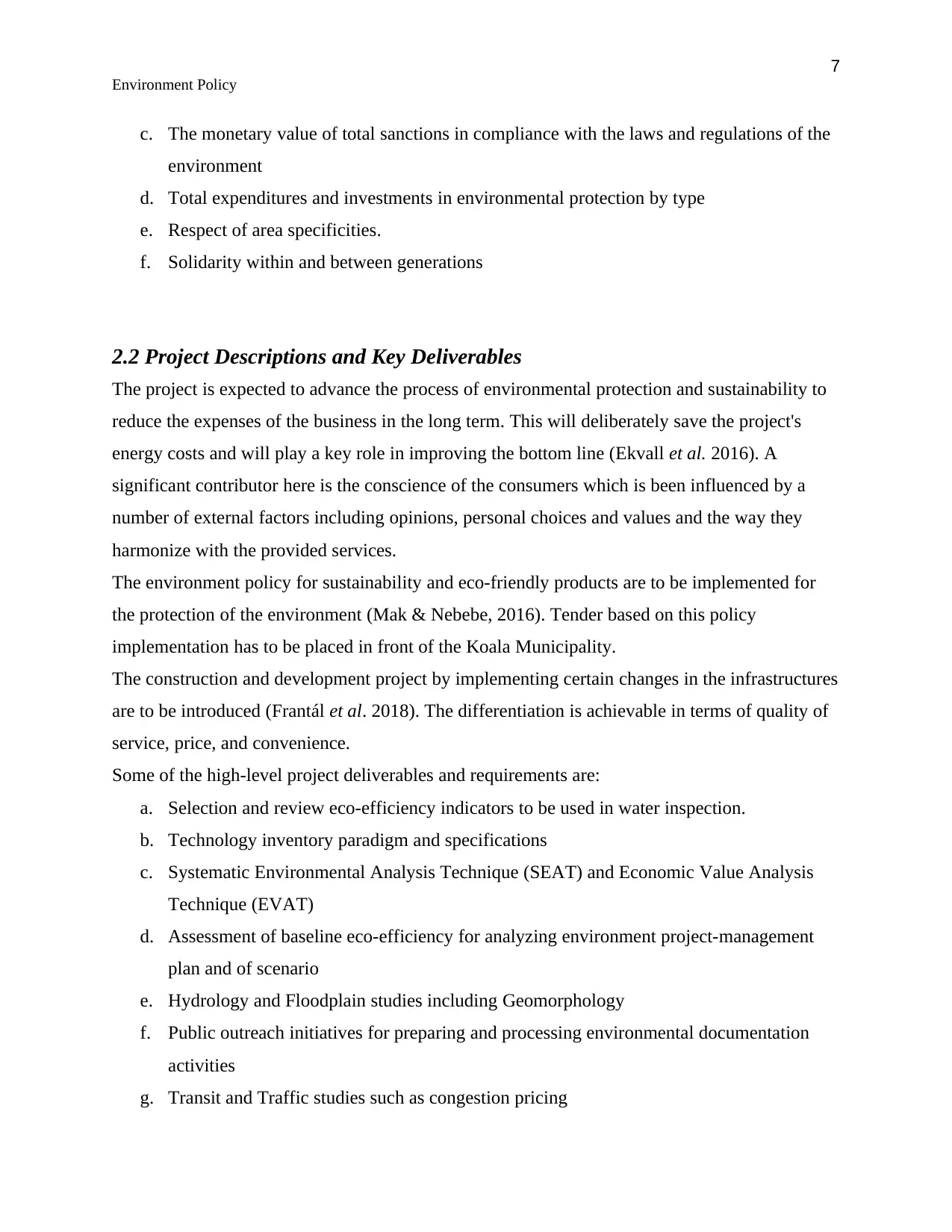
7
Environment Policy
c. The monetary value of total sanctions in compliance with the laws and regulations of the
environment
d. Total expenditures and investments in environmental protection by type
e. Respect of area specificities.
f. Solidarity within and between generations
2.2 Project Descriptions and Key Deliverables
The project is expected to advance the process of environmental protection and sustainability to
reduce the expenses of the business in the long term. This will deliberately save the project's
energy costs and will play a key role in improving the bottom line (Ekvall et al. 2016). A
significant contributor here is the conscience of the consumers which is been influenced by a
number of external factors including opinions, personal choices and values and the way they
harmonize with the provided services.
The environment policy for sustainability and eco-friendly products are to be implemented for
the protection of the environment (Mak & Nebebe, 2016). Tender based on this policy
implementation has to be placed in front of the Koala Municipality.
The construction and development project by implementing certain changes in the infrastructures
are to be introduced (Frantál et al. 2018). The differentiation is achievable in terms of quality of
service, price, and convenience.
Some of the high-level project deliverables and requirements are:
a. Selection and review eco-efficiency indicators to be used in water inspection.
b. Technology inventory paradigm and specifications
c. Systematic Environmental Analysis Technique (SEAT) and Economic Value Analysis
Technique (EVAT)
d. Assessment of baseline eco-efficiency for analyzing environment project-management
plan and of scenario
e. Hydrology and Floodplain studies including Geomorphology
f. Public outreach initiatives for preparing and processing environmental documentation
activities
g. Transit and Traffic studies such as congestion pricing
Environment Policy
c. The monetary value of total sanctions in compliance with the laws and regulations of the
environment
d. Total expenditures and investments in environmental protection by type
e. Respect of area specificities.
f. Solidarity within and between generations
2.2 Project Descriptions and Key Deliverables
The project is expected to advance the process of environmental protection and sustainability to
reduce the expenses of the business in the long term. This will deliberately save the project's
energy costs and will play a key role in improving the bottom line (Ekvall et al. 2016). A
significant contributor here is the conscience of the consumers which is been influenced by a
number of external factors including opinions, personal choices and values and the way they
harmonize with the provided services.
The environment policy for sustainability and eco-friendly products are to be implemented for
the protection of the environment (Mak & Nebebe, 2016). Tender based on this policy
implementation has to be placed in front of the Koala Municipality.
The construction and development project by implementing certain changes in the infrastructures
are to be introduced (Frantál et al. 2018). The differentiation is achievable in terms of quality of
service, price, and convenience.
Some of the high-level project deliverables and requirements are:
a. Selection and review eco-efficiency indicators to be used in water inspection.
b. Technology inventory paradigm and specifications
c. Systematic Environmental Analysis Technique (SEAT) and Economic Value Analysis
Technique (EVAT)
d. Assessment of baseline eco-efficiency for analyzing environment project-management
plan and of scenario
e. Hydrology and Floodplain studies including Geomorphology
f. Public outreach initiatives for preparing and processing environmental documentation
activities
g. Transit and Traffic studies such as congestion pricing
Paraphrase This Document
Need a fresh take? Get an instant paraphrase of this document with our AI Paraphraser
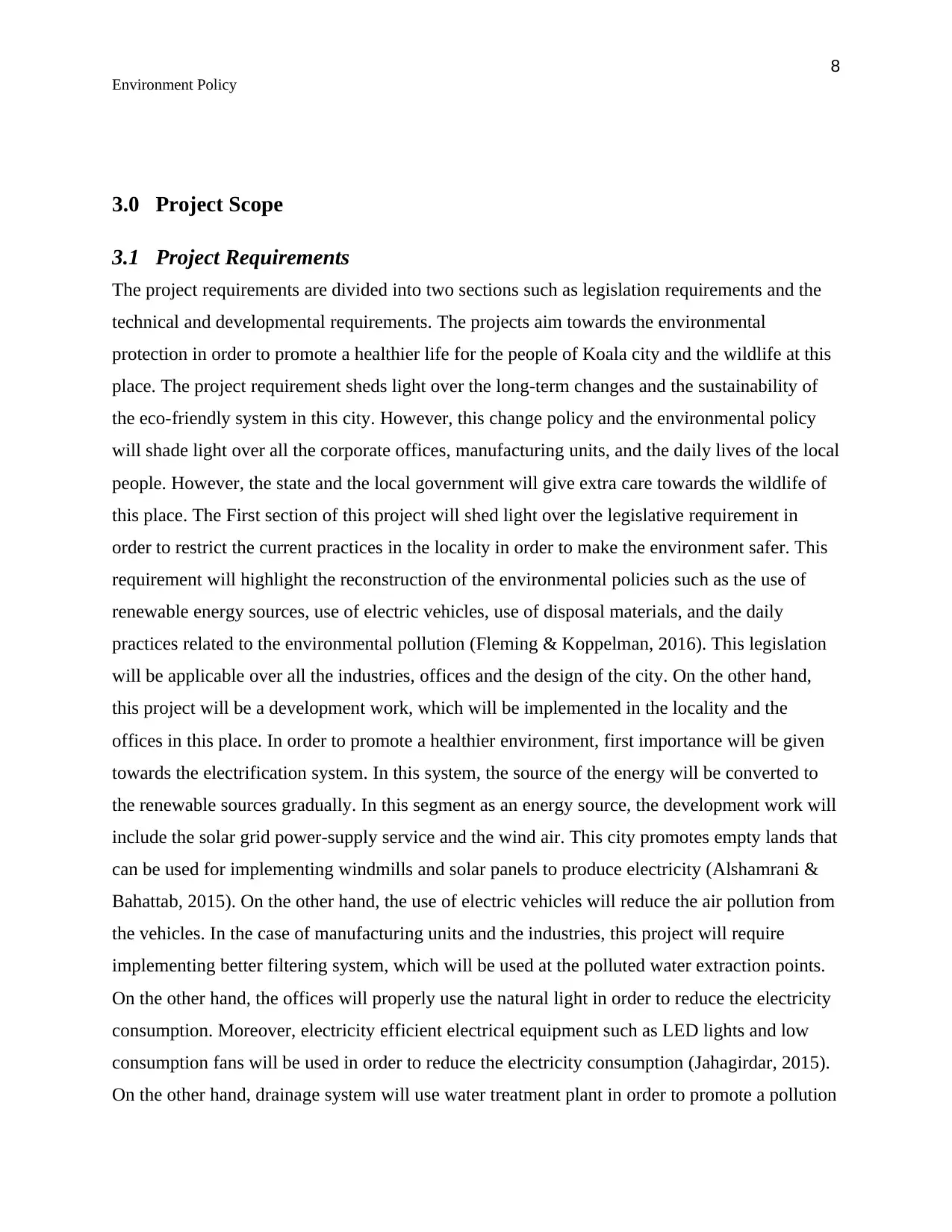
8
Environment Policy
3.0 Project Scope
3.1 Project Requirements
The project requirements are divided into two sections such as legislation requirements and the
technical and developmental requirements. The projects aim towards the environmental
protection in order to promote a healthier life for the people of Koala city and the wildlife at this
place. The project requirement sheds light over the long-term changes and the sustainability of
the eco-friendly system in this city. However, this change policy and the environmental policy
will shade light over all the corporate offices, manufacturing units, and the daily lives of the local
people. However, the state and the local government will give extra care towards the wildlife of
this place. The First section of this project will shed light over the legislative requirement in
order to restrict the current practices in the locality in order to make the environment safer. This
requirement will highlight the reconstruction of the environmental policies such as the use of
renewable energy sources, use of electric vehicles, use of disposal materials, and the daily
practices related to the environmental pollution (Fleming & Koppelman, 2016). This legislation
will be applicable over all the industries, offices and the design of the city. On the other hand,
this project will be a development work, which will be implemented in the locality and the
offices in this place. In order to promote a healthier environment, first importance will be given
towards the electrification system. In this system, the source of the energy will be converted to
the renewable sources gradually. In this segment as an energy source, the development work will
include the solar grid power-supply service and the wind air. This city promotes empty lands that
can be used for implementing windmills and solar panels to produce electricity (Alshamrani &
Bahattab, 2015). On the other hand, the use of electric vehicles will reduce the air pollution from
the vehicles. In the case of manufacturing units and the industries, this project will require
implementing better filtering system, which will be used at the polluted water extraction points.
On the other hand, the offices will properly use the natural light in order to reduce the electricity
consumption. Moreover, electricity efficient electrical equipment such as LED lights and low
consumption fans will be used in order to reduce the electricity consumption (Jahagirdar, 2015).
On the other hand, drainage system will use water treatment plant in order to promote a pollution
Environment Policy
3.0 Project Scope
3.1 Project Requirements
The project requirements are divided into two sections such as legislation requirements and the
technical and developmental requirements. The projects aim towards the environmental
protection in order to promote a healthier life for the people of Koala city and the wildlife at this
place. The project requirement sheds light over the long-term changes and the sustainability of
the eco-friendly system in this city. However, this change policy and the environmental policy
will shade light over all the corporate offices, manufacturing units, and the daily lives of the local
people. However, the state and the local government will give extra care towards the wildlife of
this place. The First section of this project will shed light over the legislative requirement in
order to restrict the current practices in the locality in order to make the environment safer. This
requirement will highlight the reconstruction of the environmental policies such as the use of
renewable energy sources, use of electric vehicles, use of disposal materials, and the daily
practices related to the environmental pollution (Fleming & Koppelman, 2016). This legislation
will be applicable over all the industries, offices and the design of the city. On the other hand,
this project will be a development work, which will be implemented in the locality and the
offices in this place. In order to promote a healthier environment, first importance will be given
towards the electrification system. In this system, the source of the energy will be converted to
the renewable sources gradually. In this segment as an energy source, the development work will
include the solar grid power-supply service and the wind air. This city promotes empty lands that
can be used for implementing windmills and solar panels to produce electricity (Alshamrani &
Bahattab, 2015). On the other hand, the use of electric vehicles will reduce the air pollution from
the vehicles. In the case of manufacturing units and the industries, this project will require
implementing better filtering system, which will be used at the polluted water extraction points.
On the other hand, the offices will properly use the natural light in order to reduce the electricity
consumption. Moreover, electricity efficient electrical equipment such as LED lights and low
consumption fans will be used in order to reduce the electricity consumption (Jahagirdar, 2015).
On the other hand, drainage system will use water treatment plant in order to promote a pollution
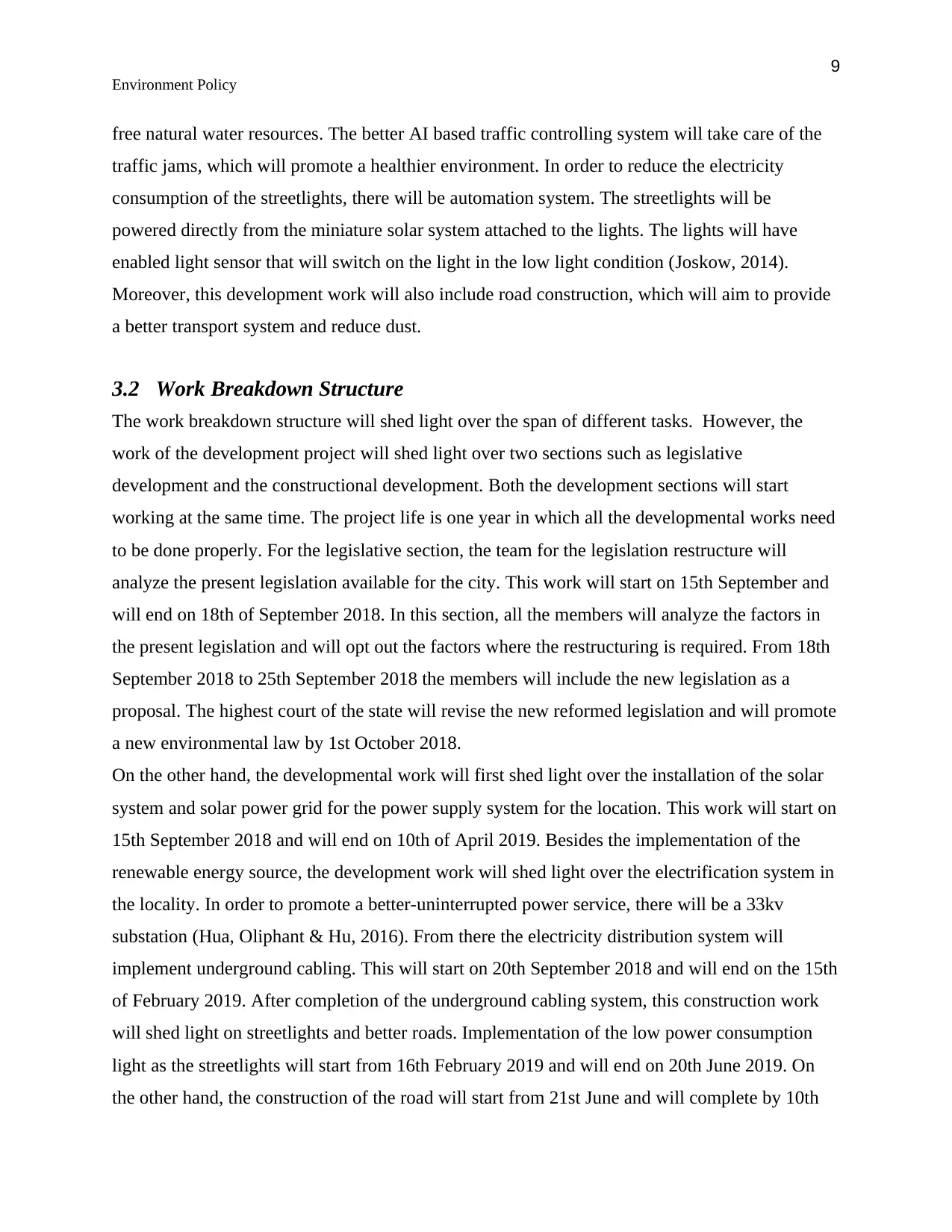
9
Environment Policy
free natural water resources. The better AI based traffic controlling system will take care of the
traffic jams, which will promote a healthier environment. In order to reduce the electricity
consumption of the streetlights, there will be automation system. The streetlights will be
powered directly from the miniature solar system attached to the lights. The lights will have
enabled light sensor that will switch on the light in the low light condition (Joskow, 2014).
Moreover, this development work will also include road construction, which will aim to provide
a better transport system and reduce dust.
3.2 Work Breakdown Structure
The work breakdown structure will shed light over the span of different tasks. However, the
work of the development project will shed light over two sections such as legislative
development and the constructional development. Both the development sections will start
working at the same time. The project life is one year in which all the developmental works need
to be done properly. For the legislative section, the team for the legislation restructure will
analyze the present legislation available for the city. This work will start on 15th September and
will end on 18th of September 2018. In this section, all the members will analyze the factors in
the present legislation and will opt out the factors where the restructuring is required. From 18th
September 2018 to 25th September 2018 the members will include the new legislation as a
proposal. The highest court of the state will revise the new reformed legislation and will promote
a new environmental law by 1st October 2018.
On the other hand, the developmental work will first shed light over the installation of the solar
system and solar power grid for the power supply system for the location. This work will start on
15th September 2018 and will end on 10th of April 2019. Besides the implementation of the
renewable energy source, the development work will shed light over the electrification system in
the locality. In order to promote a better-uninterrupted power service, there will be a 33kv
substation (Hua, Oliphant & Hu, 2016). From there the electricity distribution system will
implement underground cabling. This will start on 20th September 2018 and will end on the 15th
of February 2019. After completion of the underground cabling system, this construction work
will shed light on streetlights and better roads. Implementation of the low power consumption
light as the streetlights will start from 16th February 2019 and will end on 20th June 2019. On
the other hand, the construction of the road will start from 21st June and will complete by 10th
Environment Policy
free natural water resources. The better AI based traffic controlling system will take care of the
traffic jams, which will promote a healthier environment. In order to reduce the electricity
consumption of the streetlights, there will be automation system. The streetlights will be
powered directly from the miniature solar system attached to the lights. The lights will have
enabled light sensor that will switch on the light in the low light condition (Joskow, 2014).
Moreover, this development work will also include road construction, which will aim to provide
a better transport system and reduce dust.
3.2 Work Breakdown Structure
The work breakdown structure will shed light over the span of different tasks. However, the
work of the development project will shed light over two sections such as legislative
development and the constructional development. Both the development sections will start
working at the same time. The project life is one year in which all the developmental works need
to be done properly. For the legislative section, the team for the legislation restructure will
analyze the present legislation available for the city. This work will start on 15th September and
will end on 18th of September 2018. In this section, all the members will analyze the factors in
the present legislation and will opt out the factors where the restructuring is required. From 18th
September 2018 to 25th September 2018 the members will include the new legislation as a
proposal. The highest court of the state will revise the new reformed legislation and will promote
a new environmental law by 1st October 2018.
On the other hand, the developmental work will first shed light over the installation of the solar
system and solar power grid for the power supply system for the location. This work will start on
15th September 2018 and will end on 10th of April 2019. Besides the implementation of the
renewable energy source, the development work will shed light over the electrification system in
the locality. In order to promote a better-uninterrupted power service, there will be a 33kv
substation (Hua, Oliphant & Hu, 2016). From there the electricity distribution system will
implement underground cabling. This will start on 20th September 2018 and will end on the 15th
of February 2019. After completion of the underground cabling system, this construction work
will shed light on streetlights and better roads. Implementation of the low power consumption
light as the streetlights will start from 16th February 2019 and will end on 20th June 2019. On
the other hand, the construction of the road will start from 21st June and will complete by 10th
⊘ This is a preview!⊘
Do you want full access?
Subscribe today to unlock all pages.

Trusted by 1+ million students worldwide
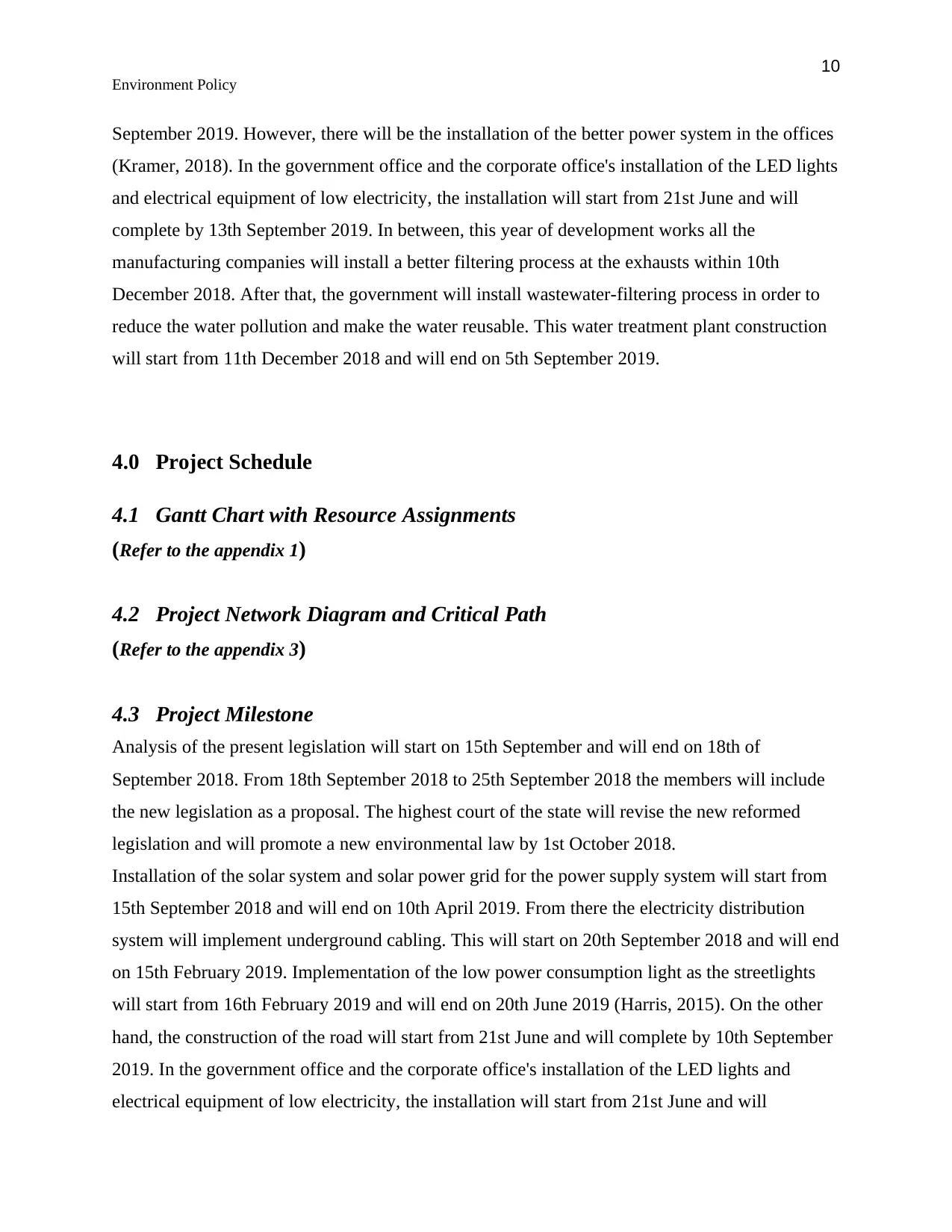
10
Environment Policy
September 2019. However, there will be the installation of the better power system in the offices
(Kramer, 2018). In the government office and the corporate office's installation of the LED lights
and electrical equipment of low electricity, the installation will start from 21st June and will
complete by 13th September 2019. In between, this year of development works all the
manufacturing companies will install a better filtering process at the exhausts within 10th
December 2018. After that, the government will install wastewater-filtering process in order to
reduce the water pollution and make the water reusable. This water treatment plant construction
will start from 11th December 2018 and will end on 5th September 2019.
4.0 Project Schedule
4.1 Gantt Chart with Resource Assignments
(Refer to the appendix 1)
4.2 Project Network Diagram and Critical Path
(Refer to the appendix 3)
4.3 Project Milestone
Analysis of the present legislation will start on 15th September and will end on 18th of
September 2018. From 18th September 2018 to 25th September 2018 the members will include
the new legislation as a proposal. The highest court of the state will revise the new reformed
legislation and will promote a new environmental law by 1st October 2018.
Installation of the solar system and solar power grid for the power supply system will start from
15th September 2018 and will end on 10th April 2019. From there the electricity distribution
system will implement underground cabling. This will start on 20th September 2018 and will end
on 15th February 2019. Implementation of the low power consumption light as the streetlights
will start from 16th February 2019 and will end on 20th June 2019 (Harris, 2015). On the other
hand, the construction of the road will start from 21st June and will complete by 10th September
2019. In the government office and the corporate office's installation of the LED lights and
electrical equipment of low electricity, the installation will start from 21st June and will
Environment Policy
September 2019. However, there will be the installation of the better power system in the offices
(Kramer, 2018). In the government office and the corporate office's installation of the LED lights
and electrical equipment of low electricity, the installation will start from 21st June and will
complete by 13th September 2019. In between, this year of development works all the
manufacturing companies will install a better filtering process at the exhausts within 10th
December 2018. After that, the government will install wastewater-filtering process in order to
reduce the water pollution and make the water reusable. This water treatment plant construction
will start from 11th December 2018 and will end on 5th September 2019.
4.0 Project Schedule
4.1 Gantt Chart with Resource Assignments
(Refer to the appendix 1)
4.2 Project Network Diagram and Critical Path
(Refer to the appendix 3)
4.3 Project Milestone
Analysis of the present legislation will start on 15th September and will end on 18th of
September 2018. From 18th September 2018 to 25th September 2018 the members will include
the new legislation as a proposal. The highest court of the state will revise the new reformed
legislation and will promote a new environmental law by 1st October 2018.
Installation of the solar system and solar power grid for the power supply system will start from
15th September 2018 and will end on 10th April 2019. From there the electricity distribution
system will implement underground cabling. This will start on 20th September 2018 and will end
on 15th February 2019. Implementation of the low power consumption light as the streetlights
will start from 16th February 2019 and will end on 20th June 2019 (Harris, 2015). On the other
hand, the construction of the road will start from 21st June and will complete by 10th September
2019. In the government office and the corporate office's installation of the LED lights and
electrical equipment of low electricity, the installation will start from 21st June and will
Paraphrase This Document
Need a fresh take? Get an instant paraphrase of this document with our AI Paraphraser
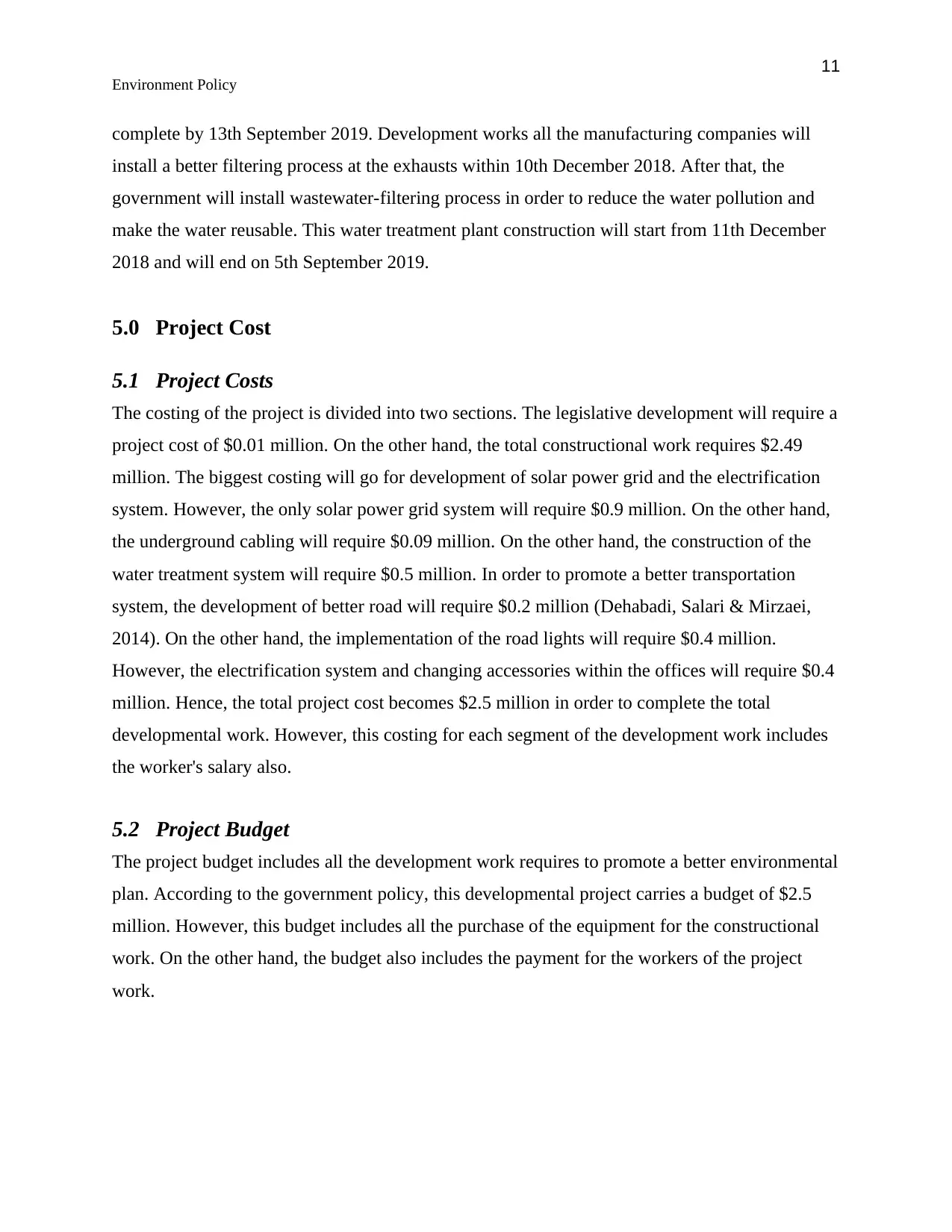
11
Environment Policy
complete by 13th September 2019. Development works all the manufacturing companies will
install a better filtering process at the exhausts within 10th December 2018. After that, the
government will install wastewater-filtering process in order to reduce the water pollution and
make the water reusable. This water treatment plant construction will start from 11th December
2018 and will end on 5th September 2019.
5.0 Project Cost
5.1 Project Costs
The costing of the project is divided into two sections. The legislative development will require a
project cost of $0.01 million. On the other hand, the total constructional work requires $2.49
million. The biggest costing will go for development of solar power grid and the electrification
system. However, the only solar power grid system will require $0.9 million. On the other hand,
the underground cabling will require $0.09 million. On the other hand, the construction of the
water treatment system will require $0.5 million. In order to promote a better transportation
system, the development of better road will require $0.2 million (Dehabadi, Salari & Mirzaei,
2014). On the other hand, the implementation of the road lights will require $0.4 million.
However, the electrification system and changing accessories within the offices will require $0.4
million. Hence, the total project cost becomes $2.5 million in order to complete the total
developmental work. However, this costing for each segment of the development work includes
the worker's salary also.
5.2 Project Budget
The project budget includes all the development work requires to promote a better environmental
plan. According to the government policy, this developmental project carries a budget of $2.5
million. However, this budget includes all the purchase of the equipment for the constructional
work. On the other hand, the budget also includes the payment for the workers of the project
work.
Environment Policy
complete by 13th September 2019. Development works all the manufacturing companies will
install a better filtering process at the exhausts within 10th December 2018. After that, the
government will install wastewater-filtering process in order to reduce the water pollution and
make the water reusable. This water treatment plant construction will start from 11th December
2018 and will end on 5th September 2019.
5.0 Project Cost
5.1 Project Costs
The costing of the project is divided into two sections. The legislative development will require a
project cost of $0.01 million. On the other hand, the total constructional work requires $2.49
million. The biggest costing will go for development of solar power grid and the electrification
system. However, the only solar power grid system will require $0.9 million. On the other hand,
the underground cabling will require $0.09 million. On the other hand, the construction of the
water treatment system will require $0.5 million. In order to promote a better transportation
system, the development of better road will require $0.2 million (Dehabadi, Salari & Mirzaei,
2014). On the other hand, the implementation of the road lights will require $0.4 million.
However, the electrification system and changing accessories within the offices will require $0.4
million. Hence, the total project cost becomes $2.5 million in order to complete the total
developmental work. However, this costing for each segment of the development work includes
the worker's salary also.
5.2 Project Budget
The project budget includes all the development work requires to promote a better environmental
plan. According to the government policy, this developmental project carries a budget of $2.5
million. However, this budget includes all the purchase of the equipment for the constructional
work. On the other hand, the budget also includes the payment for the workers of the project
work.
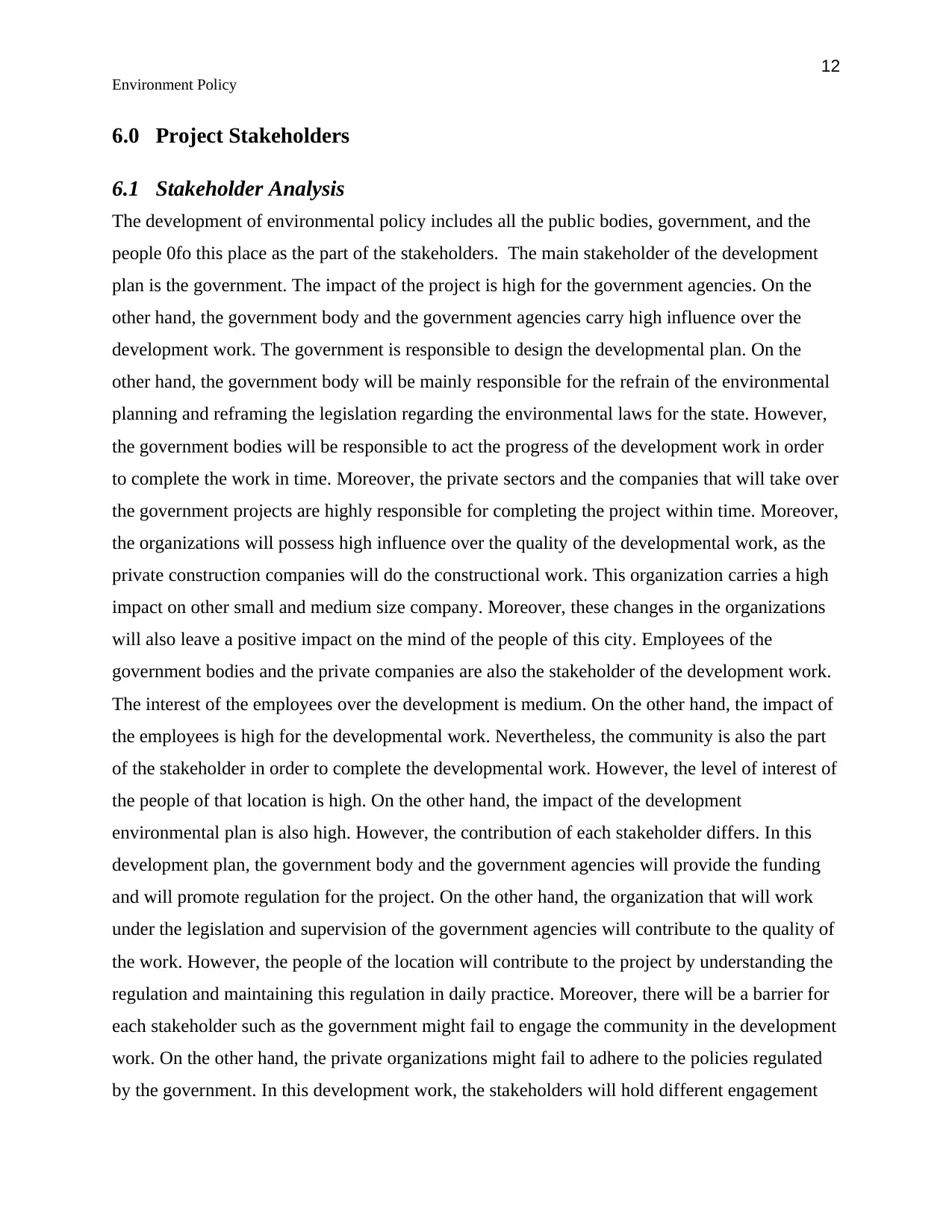
12
Environment Policy
6.0 Project Stakeholders
6.1 Stakeholder Analysis
The development of environmental policy includes all the public bodies, government, and the
people 0fo this place as the part of the stakeholders. The main stakeholder of the development
plan is the government. The impact of the project is high for the government agencies. On the
other hand, the government body and the government agencies carry high influence over the
development work. The government is responsible to design the developmental plan. On the
other hand, the government body will be mainly responsible for the refrain of the environmental
planning and reframing the legislation regarding the environmental laws for the state. However,
the government bodies will be responsible to act the progress of the development work in order
to complete the work in time. Moreover, the private sectors and the companies that will take over
the government projects are highly responsible for completing the project within time. Moreover,
the organizations will possess high influence over the quality of the developmental work, as the
private construction companies will do the constructional work. This organization carries a high
impact on other small and medium size company. Moreover, these changes in the organizations
will also leave a positive impact on the mind of the people of this city. Employees of the
government bodies and the private companies are also the stakeholder of the development work.
The interest of the employees over the development is medium. On the other hand, the impact of
the employees is high for the developmental work. Nevertheless, the community is also the part
of the stakeholder in order to complete the developmental work. However, the level of interest of
the people of that location is high. On the other hand, the impact of the development
environmental plan is also high. However, the contribution of each stakeholder differs. In this
development plan, the government body and the government agencies will provide the funding
and will promote regulation for the project. On the other hand, the organization that will work
under the legislation and supervision of the government agencies will contribute to the quality of
the work. However, the people of the location will contribute to the project by understanding the
regulation and maintaining this regulation in daily practice. Moreover, there will be a barrier for
each stakeholder such as the government might fail to engage the community in the development
work. On the other hand, the private organizations might fail to adhere to the policies regulated
by the government. In this development work, the stakeholders will hold different engagement
Environment Policy
6.0 Project Stakeholders
6.1 Stakeholder Analysis
The development of environmental policy includes all the public bodies, government, and the
people 0fo this place as the part of the stakeholders. The main stakeholder of the development
plan is the government. The impact of the project is high for the government agencies. On the
other hand, the government body and the government agencies carry high influence over the
development work. The government is responsible to design the developmental plan. On the
other hand, the government body will be mainly responsible for the refrain of the environmental
planning and reframing the legislation regarding the environmental laws for the state. However,
the government bodies will be responsible to act the progress of the development work in order
to complete the work in time. Moreover, the private sectors and the companies that will take over
the government projects are highly responsible for completing the project within time. Moreover,
the organizations will possess high influence over the quality of the developmental work, as the
private construction companies will do the constructional work. This organization carries a high
impact on other small and medium size company. Moreover, these changes in the organizations
will also leave a positive impact on the mind of the people of this city. Employees of the
government bodies and the private companies are also the stakeholder of the development work.
The interest of the employees over the development is medium. On the other hand, the impact of
the employees is high for the developmental work. Nevertheless, the community is also the part
of the stakeholder in order to complete the developmental work. However, the level of interest of
the people of that location is high. On the other hand, the impact of the development
environmental plan is also high. However, the contribution of each stakeholder differs. In this
development plan, the government body and the government agencies will provide the funding
and will promote regulation for the project. On the other hand, the organization that will work
under the legislation and supervision of the government agencies will contribute to the quality of
the work. However, the people of the location will contribute to the project by understanding the
regulation and maintaining this regulation in daily practice. Moreover, there will be a barrier for
each stakeholder such as the government might fail to engage the community in the development
work. On the other hand, the private organizations might fail to adhere to the policies regulated
by the government. In this development work, the stakeholders will hold different engagement
⊘ This is a preview!⊘
Do you want full access?
Subscribe today to unlock all pages.

Trusted by 1+ million students worldwide
1 out of 30
Related Documents
Your All-in-One AI-Powered Toolkit for Academic Success.
+13062052269
info@desklib.com
Available 24*7 on WhatsApp / Email
![[object Object]](/_next/static/media/star-bottom.7253800d.svg)
Unlock your academic potential
Copyright © 2020–2025 A2Z Services. All Rights Reserved. Developed and managed by ZUCOL.




